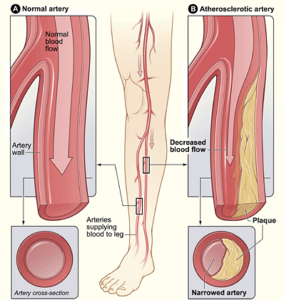Can a regular exercise program, if begun sooner in life, actually prevent the occurrence of peripheral artery disease?
This would assume that the individual also doesn’t smoke, sticks to an artery-healthy diet and is not overweight.
Have you ever believed that a rigorous exercise regimen of intense squats, weighted walking lunges, burning leg presses, box jumping, hill dashing and treadmill sprints could outright prevent the development of peripheral artery disease?
This article isn’t about the benefits of exercise after the diagnosis of PAD, but rather, exercise as a preventive force.
“PAD comes in many shapes and forms,” begins Craig Walker, MD, interventional cardiologist, Founder, President and Medical Director, Cardiovascular Institute of the South.
“The most common form of peripheral artery disease is atherosclerotic, but there are forms such as popliteal entrapment syndrome which may be worsened by exercise as the artery is squeezed by the heads of the gastrocnemius muscle.”

National Heart Lung and Blood Institute
But this squeezing wouldn’t be a problem if the disease were prevented in the first place.
Atherosclerotic refers to the plaque buildup in the leg arteries. The popliteal artery is located behind the knee. The gastrocnemius is the major calve muscle that enables you to go up on the balls of your feet, jump, run, climb stairs and more.
“I know of no articles or studies clearly showing a lowered incidence of atherosclerotic PAD with exercise, but there are many publications showing a dramatic functional improvement in patients with peripheral artery disease who perform structured walking programs,” continues Dr. Walker.
Walking for PAD
A structured walking program is that which occurs above your baseline level of walking.
In other words, the walking you do on the job, around the house or while shopping does NOT count. Structured walking exercise means continuous, nonstop, with a good arm pump and elevated heart rate.
“Structured exercise programs may facilitate development of collateral vessels (natural bypasses) which may provide ample blood flow even with totally obstructed main vessels,” explains Dr. Walker.
“The greatest risk factors for developing atherosclerotic PAD are advanced age, diabetes and smoking. I suspect increased aerobic exercise may have preventive benefit, but can’t cite any studies.”
The absence of studies investigating exercise as a prevention for peripheral artery disease does not mean that exercise can’t provide a significant preventive effect.
The absence simply means that this area of research has not been tapped.


 Dr. Walker
Dr. Walker























